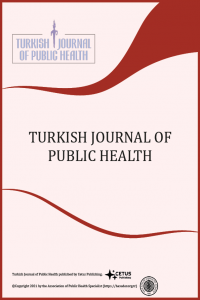Türkiye’deki intiharların yaşa, cinsiyete ve yönteme göre değişim trendi, 2002–2015
Amaç: Çalışmada, Türkiye’de, 2002-2015 zaman aralığında, yaşa, cinsiyete ve yönteme özel intihar hızlarında meydana gelen değişimin değerlendirilmesi amaçlandı. Yöntem: Türkiye İstatistik Kurumu’ndan elde edilen verilerle, çalışma periyodunda yaşa, cinsiyete ve yönteme özel intihar hızları hesaplandı ve bu hızların incelenen zaman trendinde gösterdiği değişimin incelenmesinde Joinpoint regresyon analizi kullanıldı. Bulgular: İncelenen zaman trendinde kaydedilen 40,281 intiharın 27,407’si erkek (%68), 12,874’ü kadın (%32) idi. Intihar hızı sadece 15 yaşın altında olan grupta kadınlarda erkeklere göre daha yüksek iken, diğer yaş gruplarında erkeklerde daha yüksekti. İncelenen zaman trendinde, erkeklerde intihar hızı 15 yaşın altında, 25-44, 65 yaş ve üzerindeki yaş gruplarında anlamlı bir artış trendi gösterdi. Tüm yaş gruplarında en çok tercih edilen intihar yöntemi ası idi. Ateşli silah kullanımıyla gerçekleşen intiharların, 15 yaşın altında olan grupta artış trendi göstermesi dikkat çekiciydi. Sonuç: İntihar davranışının, yıllar içinde gösterdiği değişim trendi daha yakından izlenmelidir. Artan intihar hızlarının önüne geçebilmek için, acilen önleyici tedbirlerin alınmasına ihtiyaç vardır.
Anahtar Kelimeler:
İntihar hızı, intihar trendi, intihar yöntemleri, zaman seri analizi
Suicide mortality trends by age, gender and method in Turkey
Objective: The aim of this study was to evaluate the change in the gender, age and method-specific suicide rates in Turkey between 2002-2015. Method: Gender, age and method-specific suicide rates were calculated during the study period with the data obtained from the Turkish Statistical Institute and Joinpoint regression analysis was used to test the change of these rates within the observed time period. Results: Of a total of 40,281 suicides recorded during the study period, 27,407 consisted of males (68%) and 12,874 consisted of females (32%). The suicide rate was higher in females than males only in the group under 15 years of age, whereas it was higher in males than females in all other age groups. Male suicides showed an increasing trend in the time interval studied for the age groups under 15, 25-44, 65 and above. The most commonly used suicide method was hanging in all age groups. It was noteworthy that suicides committed by firearms also increased in the group under 15 years of age. Conclusion: Trend in suicidal behavior over the years should be closely monitored. Preventive measures to curb increasing trends of suicide are urgently needed.
Keywords:
suicide rate, trends of suicide, methods of suicide, time series analysis,
___
- 1. Rao D, Namaratha P, Rao T, Raman R. European Psychiatry. 2015;30:966.
- 2. Suicide WP. A global imperative. World Health Organization. 2014.
- 3. MacIsaac MB, Bugeja L, Weiland T, Dwyer J, Selvakumar K, Jelinek GA. Prevalence and characteristics of interpersonal violence in people dying from suicide in Victoria, Australia. Asia Pacific Journal of Public Health. 2017:1010539517743615.
- 4. Detels R, Gulliford M, Karim QA. Oxford textbook of global public health: Oxford University Press, USA; 2015.
- 5. Yoshioka E, Hanley S, Kawanishi Y, Saijo Y. Time trends in method-specific suicide rates in Japan, 1990–2011. Epidemiology and psychiatric sciences. 2016;25(01):58-68.
- 6. World Health Organization. Suicide rates (per 100 000 population). http://www.who.int/gho/mental_health/suicide_rates/en/. Accessed May 1, 2017.
- 7. Metintaş S. Public Health Perspective in Suicides. Turkiye klinikleri journal of public health-special topic. 2016;2(1):55-64.
- 8. Oner S, Yenilmez C, Ozdamar K. Sex-related differences in methods of and reasons for suicide in Turkey between 1990 and 2010. Journal of international medical research. 2015;43(4):483-93.
- 9. National Cancer Institute. Standard population data, World (WHO 2000-2025) Standard. https://seer.cancer.gov/stdpopulations/world.who.html. Accessed July 13, 2017.
- 10. National Cancer Institute. Joinpoint trend analysis software. https://surveillance.cancer.gov/joinpoint/. Accessed July 14, 2017.
- 11. Oner S, Yenilmez C, Ayranci U, Gunay Y, Ozdamar K. Sexual differences in the completed suicides in Turkey. European psychiatry. 2007;22(4):223-8.
- 12. Lester D. Suicide and islam. Archives of suicide research. 2006;10(1):77-97.
- 13. Vichi M, Masocco M, Pompili M, Lester D, Tatarelli R, Vanacore N. Suicide mortality in Italy from 1980 to 2002. Psychiatry research. 2010;175(1):89-97.
- 14. Puzo Q, Qin P, Mehlum L. Long-term trends of suicide by choice of method in Norway: a joinpoint regression analysis of data from 1969 to 2012. BMC public health. 2016;16(1):255.
- 15. Siyez DM. Attempts Of Commıtıng Suıcıde In The Perıod Of Puberty: A Revıew. Kastamonu Eğitim Dergisi. 2006;14(2):413-20.
- 16. Lin J-J, Lu T-H. Suicide mortality trends by sex, age and method in Taiwan, 1971–2005. BMC Public Health. 2008;8(1):6.
- 17. Bando DH, Brunoni AR, Fernandes TG, Benseñor IM, Lotufo PA. Suicide rates and trends in São Paulo, Brazil, according to gender, age and demographic aspects: a joinpoint regression analysis. Revista Brasileira de Psiquiatria. 2012;34(3):286-93.
- 18. Baumert J, Erazo N, Ruf E, Ladwig K-H. Time trends in suicide mortality vary in choice of methods. Social psychiatry and psychiatric epidemiology. 2008;43(11):913.
- 19. Starkuviene S, Kalediene R, Petrauskiene J. Epidemic of suicide by hanging in Lithuania: does socio-demographic status matter? Public health. 2006;120(8):769-75.
- 20. Gunnell D, Bennewith O, Hawton K, Simkin S, Kapur N. The epidemiology and prevention of suicide by hanging: a systematic review. International Journal of Epidemiology. 2005;34(2):433-42.
- 21. The Republic of Turkey. Law on gun and other knitting tools and knaps. http://www.mevzuat.gov.tr/MevzuatMetin/1.3.6136.pdf. Accessed July 1, 2017.
- 22. Grossman DC, Mueller BA, Riedy C, Dowd MD, Villaveces A, Prodzinski J, et al. Gun storage practices and risk of youth suicide and unintentional firearm injuries. Jama. 2005;293(6):707-14.
- 23. Gunnell D, Nowers M. Suicide by jumping. Acta Psychiatrica Scandinavica. 1997;96(1):1-6.
- Başlangıç: 2003
- Yayıncı: Halk Sağlığı Uzmanları Derneği
Sayıdaki Diğer Makaleler
Bir tıp fakültesindeki öğrencilerin depresyon, anksiyete ve stres düzeylerinin değerlendirilmesi
Aylin YENİOCAK TUNÇ, Gülçin YAPICI
Cavit İşık YAVUZ, Naci ÇİNE, Songül A. VAİZOĞLU, Çağatay GÜLER
Türkiye’deki intiharların yaşa, cinsiyete ve yönteme göre değişim trendi, 2002–2015
Maternal sigara maruziyeti çocukluk döneminde obezojenik etkili midir?
Mohammad Haris ABDİANWALL, Bahar GÜÇİZ DOĞAN
Sel sonrasında görülen post-travmatik stres bozukluğu: Kesitsel bir çalışma
Nazım Ercüment BEYHUN, Asuman YAVUZYILMAZ, Demet SAĞLAM, Köksal HAMZAOĞLU, Yusuf DEMİRTAŞ, İrem DİLAVER, Gufran ACAR, Büşra PARLAK, Kübra ŞAHİN, Gamze ÇAN, Murat TOPBAŞ
Ümit KILIÇ, Burcu YÖN, Nuriye YILDIRIM ŞİŞMAN
